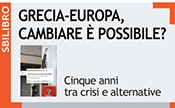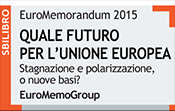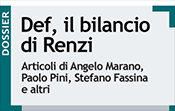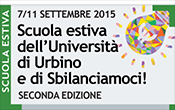Ultimi link in questa sezione
Dr Marchionne’s Vietnam War
In 1968, at the height of the Tet offensive, I argued with US sociologist Edward Shils (1910-1995) at Cambridge about the uselessness, wickedness and immorality of the Vietnam war. Shils shut me up curtly by saying that the US were in Vietnam simply “because they can”, and there was nothing more to be said. And so they could, of course: the US had the troops, the military hardware, the financial resources to do it, and they could get away with it, wanting to get away with it (at the time). Which of course did not imply that the war was in the US' best interests, that it was justifiable, or that the US would win it in the end. Shils lived long enough to see the inglorious débacle of the US last exit by helicopter from the roof of the US Embassy in Saigon.
In 2010 FIAT's Sergio Marchionne adopted an antagonistic industrial relations strategy towards his employees, first at the Pomigliano d’Arco plant in Southern Italy and then at the Mirafiori plant in Turin. Either FIAT employees accepted greater internal flexibility, duration and intensity of work or FIAT would invest an alleged €20bn elsewhere, notably in Serbia and in Canada. At Pomigliano a workers' referendum endorsed the deal but the overwhelming majority of over 60% was judged insufficient by Marchionne. At the Turin Mirafiori plant on 29 December FIAT signed an agreementwith all unions (Fim, Uilm e Fimsic) except with the traditionally more militant FIOM metalworkers. Now a referendum has been called on 13-14 January, and FIOM has called a general strike for 28 January inviting not only metalworkers but all "social opposition forces" from students to movements opposing water privatisation.
Marchionne’s attitude is reminiscent of Shils’ views on the Vietnam War: FIAT is fighting the metalworkers’ Trade Union FIOM “because it can”. Globalisation has dramatically increased labour markets competition in the world: labour migrations and production de-localisation are the more spectacular forms of such intensified competition, but trade liberalisation is its most important quantitative manifestation. Even if existing factories stayed for ever where they are, new production would naturally follow the logic of global comparative advantage. This is what has reduced the average share of wages in GDP in advanced countries from 65% to 55% in 1980-2005 (IMF World Economic Outlook June 2007), a trend that has continued to date except for a small rise in wage shares in 2009 due to the temporary fall of profits in the recession. This is what allows FIAT to give such a blunt ultimatum to its workers: take it or leave it, don’t even think you can negotiate anything else.
The former communist leader Piero Fassino – now candidate as mayor of Turin, FIAT’s headquarters – has stated that were he a FIAT employee he would support the proposed deal and vote Yes in the coming referendum. Other Democratic Party politicians have dissented: Marchionne has already succeeded in splitting not only the Unions but also the main Opposition party. (See Antonio Lettieri, "La sinistra ai piedi di Marchionne", Il Manifesto, 8-01-2011).
One’s vote in such a referendum is not necessarily a reflection of one’s politics, but of family circumstances and wealth. Were I a FIAT employee, faced with the brutal alternative between unemployment and a worsening of my labour conditions I too might well vote Yes in the referendum. Which does not imply that the deal is in FIAT’s best interests, indeed that it is necessarily superior to other deals reachable after negotiation, or that its political/social implications are desirable, especially in the long run.
Some aspects of the proposed deal are very disquieting. The proposal has not been discussed beforehand, even within those Unions that have supported it. Such referendums, overriding union leadership, are unprecedented so that there are no set rules: at Pomigliano a yes vote of over 60% was regarded as insufficient for FIAT to go ahead with investment; at Mirafiori Marchionne demands only “over 51%”. An unintended consequence of existing Italian legislation involves FIOM members losing the right to union representation unless FIOM signs the deal. This could be rectified easily by either government decree or by an additional provision in the agreement with FIAT, before the referendum takes place, but neither Italy’s weak, absentee and corrupt government nor FIAT have taken the initiative, in spite of protestations by several unions and politicians and not just by FIOM. The threat of losing union representation poses additional and improper pressure on FIOM members. The deal marks the end of collective bargaining – which is, among other things, an integral part of the European Social Model – and marks the re-emergence of enterprise-level bargaining outside medium and small size firms. FIAT has had to leave the Confederation of Italian Industries in order to replace the standing collective contract, but metalworkers could also be moved to the new contract in other enterprises that followed FIAT’s example.
A major problem is that FIAT’s so-called “Fabbrica Italia” project does not really guarantee FIAT’s employees anything at all. The €20bn investment “envisaged” – with an unspecified time-horizon – exists only in the vaguest and most nebulous industrial plan not worth the paper on which it is not written. So far only €1,3bn have been “planned”, only another €700mn have been identified at the very outset.
The new contract would be signed with a New Company, a joint venture with Chrysler. As is always the case with multinational companies, including joint ventures, the distribution of profits between FIAT and Chrysler would depend on transfer prices of components between the two partners. The criteria for such distribution has not been remotely faced by the parties, or even raised by the Unions.
The greater flexibility, the acceleration and prolongation of worktime involved in the deal seem too minor to really impact FIAT’s global competitiveness but represents merely a net worsening of working conditions. They are 1) a shortening of 10 minutes per day in work pauses (three 10’ pauses instead of two 15’ and one 10’ pauses) compensated by €0.1877 per worked hour or roughly €45 per month; 2) the postponement of the 30 minutes meal break to the end of the shift; 3) loss of illness allowance for period of “anomalous absenteeism” to be assessed case by case by a joint committee; 4) up to 18 8-hour shifts over six working days; 5) up to 120 hours overtime work without having to negotiate with the Unions, plus another 80 hours with union agreement; 6) in case of strikes or other breaches of contract FIAT would not be liable to honour union permits and payments.
Would such greater internal flexibility, prolongation and intensification of work solve FIAT’s problems and miraculously restore competitiveness in a sector affected by world-wide supply over-capacity and demand recession? (see a letter endorsed by 146 Italian economists on the subject, on the Sbilanciamoci website. )
Fact 1. In 2009 FIAT produced 650 thousand cars in Italy, barely a third of those produced in 1990, compared to a planned 2mn and to the stability and growth of quantities produced in the major European countries. The stated intention of more than doubling output seems over-optimistic.
Fact 2. FIAT spends on productive investments, and on Research & Development, shares of turnover significantly lower than those of its main European competitors, and it is not active in the development of low environmental impact alternatives. European competitors of FIAT, like Volkswagen, have responded to crisis by reducing working hours while protecting wages and employment.
Fact 3. While in 2004-2008 FIAT recovered from a very serious crisis and developed a few models, in the last two years FIAT has not introduced any new models; its market share in Europe has fallen to 6.7%, the largest drop in car output shares in Europe in 2010.
Fact 4. In 2010 Fiat shares rose 90%, beating all competitors, also following the recent split of Fiat Industrial from the rest of the company involved in car production. In the third quarter of 2010 FIAT was first in the Italian stock exchange in terms of shareholder value, with a 33% return on capital.
Fact 5. In spite of the rhetoric of FIAT depicted as an enterprise “capable to walk in the market on its own legs”, from the end of the 1980s and the early 2000s FIAT has enjoyed public subsidies of the order of €500mn per year. Perhaps FIAT should have been given subsidies to deal with the crisis by the Italian government, or at least Marchionne should have asked.
Fact 6. Over the last ten years FIAT global employment in car production has fallen from 74 thousand to 54 thousand units, of which only 22,000 are in Italian factories. Employees have average skill levels lower than those of FIAT’s competitors, and among the lowest wages in the sector in Europe.
Fact 7. In 2004-2009 Dr Marchionne earned €36.6mn euro, including the accumulation of his golden handshake, i.e. €6.3mn a year. Plus 4million free shares, worth 69.8mn on 7 January 2011, which will have appreciated further already since then. This brings his yearly income to €38.8 mn a year (See Massimo Mucchetti, "Marchionne e lo stipendio del dipendente FIAT", Corriere della Sera, 9 January 2011), which corresponds to 1,037 times the average yearly cost of Italian metalworkers' labour over the same period. Not that this matters for the plausibility of FIAT’s industrial policy stance but certainly not an irrelevant consideration in providing a perspective for the average FIAT metalworker, whether or not she is a FIOM member.










